Determination of Soil Agricultural Aptitude for Sugar Cane Production in Vertisols with Machine Learning
Abstract
1. Introduction
2. Materials and Methods
2.1. Study Case
2.2. Soil Sampling and Physicochemical Determinations
2.3. Soil Aptitude Evaluation
2.4. Machine Learning
2.5. Feature Importance Analysis
2.6. Agricultural Capability Prediction
2.7. Physicochemical Variables Prediction
3. Results
3.1. Soil Aptitude Evaluation
3.2. Feature Importance Results
3.3. Agricultural Capability Prediction Results
3.4. Physicochemical Parameters Prediction Results
4. Discussion
5. Conclusions
Author Contributions
Funding
Informed Consent Statement
Data Availability Statement
Acknowledgments
Conflicts of Interest
Abbreviations
| Ca | Calcium |
| Ca/Mg | Calcium/Magnesium |
| CARS | Competitive adaptive weight weighting algorithm |
| CB | CatBoost |
| CEC | Cation exchange capacity |
| CS H | Cationic Saturation for Hydrogen |
| CS N | Cationic Saturation for Nitrogen |
| Cu | Copper |
| DBSCAN | Density-Based Spatial Clustering of Applications with Noise |
| DL | Deep Learning |
| DT | Decision Tree |
| EO | Expert opinion |
| K | Potassium |
| KNN | K nearest neighbor |
| LASSO | least absolute shrinkage and selection operator |
| LR | Linear Regression |
| Mg | Magnesium |
| ML | Machine Learning |
| Mn | Manganese |
| N2-NO3 | Nitrogen - Nitrate |
| NPK | Amount of Nitrogen, Phosphorus and Potassium |
| OC | Organic Carbon |
| OM | Organic Matter |
| P | Phosphorus |
| PCA | Principal Component Analysis |
| PCR | Principal Component Regression |
| pH | Potential of hydrogen |
| PLSR | Partial Least Squares Regression |
| RF | Random Forest |
| RFE | Recursive Feature Elimination |
| RR | Relative Risks |
| S | Sulfur |
| SIMPLS | An alternative approach to partial least squares regression |
| SPA | Smart Process Automation |
| SQI | Soil Quality Indexes |
| SVM | Support Vector Machine |
| VIRS | Visible near Infrared Spectroscopy |
| WNN | Wavelet Neural Network |
| Zn | Zinc |
References
- FAO. International Soil Classification System for Naming Soils and Creating Legends for Soil Maps; World Soil: Rome, Italy, 2015; p. 203. Available online: https://www.fao.org/3/i3794en/I3794en.pdf (accessed on 28 June 2023).
- Secretaría de Agricultura, Ganadería, Desarrollo Rural, Pesca y Alimentación. Reporte Final de Producción de Caña y Azucar Zafra 2017/2018. 2018. Available online: https://www.gob.mx/cms/uploads/attachment/file/371833/REPORTE_FINAL_.pdf (accessed on 28 June 2023).
- Durán, R.Q.; Sánchez, A.G.; Lombana, A.C.; Arboleda, F.M.; Aguas, J.S.T.; González, J.A.C.; Murillo, C.A.O. Grupos Homogéneos de Suelos del área Dedicada al Cultivo de la caña de Azúcar en el valle del río Cauca (Segunda Aproximación); Publicación Cenicaña: Cali, Colombia, 2008. [Google Scholar]
- Rivera, N.A.; Vargas, L.A.O.; Mendoza, G.G. Evaluación de aptitud de tierras al cultivo de caña de azúcar en la Huasteca potosina, México, por técnicas geomáticas. Rev. Geogr. Norte Gd. 2013, 55, 141–156. [Google Scholar] [CrossRef]
- Chami, D.E.; Daccache, A.; Moujabber, M.E. What are the impacts of sugarcane production on ecosystem services and human well-being? A review. Ann. Agric. Sci. 2020, 65, 188–199. [Google Scholar] [CrossRef]
- Sánchez, P.; Ortiz, C.; Gutiérrez, M.; Gómez, J. Local Land Classification and its Relationship with Sugarcane Crop in the South of Veracruz. Terra 2002, 20, 359–369. [Google Scholar]
- Romero, J.R.; Roncallo, P.F.; Akkiraju, P.C.; Ponzoni, I.; Echenique, V.C.; Carballido, J.A. Using classification algorithms for predicting durum wheat yield in the province of Buenos Aires. Comput. Electron. Agric. 2013, 96, 173–179. [Google Scholar] [CrossRef]
- Dorado, H.; Delerce, S.; Jimenez, D.; Cobos, C. Finding optimal farming practices to increase crop yield through global-best harmony search and predictive models, a data-driven approach. In Lecture Notes in Computer Science (Including Subseries Lecture Notes in Artificial Intelligence and Lecture Notes in Bioinformatics); Springer: Berlin/Heidelberg, Germany, 2018; 11289 LNAI; pp. 15–29. [Google Scholar] [CrossRef]
- Sethy, P.K.; Panigrahi, G.R.; Barpanda, N.K.; Behera, S.K.; Rath, A.K. Application of Soft Computing in Crop Management; Springer: Singapore, 2018; Volume 695, pp. 633–646. [Google Scholar] [CrossRef]
- Moncada, M.P.; Gabriels, D.; Cornelis, W.M. Data-driven analysis of soil quality indicators using limited data. Geoderma 2014, 235–236, 271–278. [Google Scholar] [CrossRef]
- Shankar, S.V.; Radha, M.; Kumaraperumal, R.; Gowsar, S.N. Statistical evaluation of physico-chemical properties of Soils of Coimbatore district using Dimensionality Reduction Technique S.Vishnu. Int. Arch. Appl. Sci. Technol. 2019, 10, 84–89. [Google Scholar]
- Tesfahunegn, G.B. Soil quality assessment strategies for evaluating soil degradation in Northern Ethiopia. Appl. Environ. Soil Sci. 2014, 2014, 646502. [Google Scholar] [CrossRef]
- Armenise, E.; Redmile-Gordon, M.A.; Stellacci, A.M.; Ciccarese, A.; Rubino, P. Developing a soil quality index to compare soil fitness for agricultural use under different managements in the mediterranean environment. Soil Tillage Res. 2013, 130, 91–98. [Google Scholar] [CrossRef]
- Vasu, D.; Singh, S.K.; Ray, S.K.; Duraisami, V.P.; Tiwary, P.; Chandran, P.; Nimkar, A.M.; Anantwar, S.G. Soil quality index (SQI) as a tool to evaluate crop productivity in semi-arid Deccan plateau, India. Geoderma 2016, 282, 70–79. [Google Scholar] [CrossRef]
- de Paul Obade, V.; Lal, R. A standardized soil quality index for diverse field conditions. Sci. Total Environ. 2016, 541, 424–434. [Google Scholar] [CrossRef]
- Lal, R. Restoring soil quality to mitigate soil degradation. Sustainability 2015, 7, 5875–5895. [Google Scholar] [CrossRef]
- Shao, Z.; Zhang, L.; Wang, L. Stacked Sparse Autoencoder Modeling Using the Synergy of Airborne LiDAR and Satellite Optical and SAR Data to Map Forest Above-Ground Biomass. IEEE J. Sel. Top. Appl. Earth Obs. Remote Sens. 2017, 10, 5569–5582. [Google Scholar] [CrossRef]
- Faming, H.; Jing, Z.; Chuangbing, Z.; Yuhao, W.; Jinsong, H.; Li, Z. A deep learning algorithm using a fully connected sparse autoencoder neural network for landslide susceptibility prediction. Landslides 2020, 17, 217–229. [Google Scholar] [CrossRef]
- de Bem, P.P.; de Carvalho Júnior, O.A.; de Carvalho, O.L.F.; Gomes, R.A.T.; Fontes Guimarães, R. Performance Analysis of Deep Convolutional Autoencoders with Different Patch Sizes for Change Detection from Burnt Areas. Remote Sens. 2020, 12, 2576. [Google Scholar] [CrossRef]
- Hounkpatin, K.O.; Bossa, A.Y.; Yira, Y.; Igue, M.A.; Sinsin, B.A. Assessment of the soil fertility status in Benin (West Africa)—Digital soil mapping using machine learning. Geoderma Reg. 2022, 28, e00444. [Google Scholar] [CrossRef]
- Xu, M.; Chu, X.; Fu, Y.; Wang, C.; Wu, S. Improving the accuracy of soil organic carbon content prediction based on visible and near-infrared spectroscopy and machine learning. Environ. Earth Sci. 2021, 80, 326. [Google Scholar] [CrossRef]
- Dong, Z.; Wang, N.; Liu, J.; Xie, J.; Han, J. Combination of machine learning and VIRS for predicting soil organic matter. J. Soils Sediments 2021, 21, 2578–2588. [Google Scholar] [CrossRef]
- Wang, Z.; Wang, G.; Ren, T.; Wang, H.; Xu, Q.; Zhang, G. Assessment of soil fertility degradation affected by mining disturbance and land use in a coalfield via machine learning. Ecol. Indic. 2021, 125, 107608. [Google Scholar] [CrossRef]
- Singh, B.; Sihag, P.; Pandhiani, S.M.; Debnath, S.; Gautam, S. Estimation of permeability of soil using easy measured soil parameters: Assessing the artificial intelligence-based models. ISH J. Hydraul. Eng. 2021, 27, 38–48. [Google Scholar] [CrossRef]
- Vaheddoost, B.; Guan, Y.; Mohammadi, B. Application of hybrid ANN-whale optimization model in evaluation of the field capacity and the permanent wilting point of the soils. Environ. Sci. Pollut. Res. 2020, 27, 13131–13141. [Google Scholar] [CrossRef]
- Helfer, G.A.; Barbosa, J.L.V.; dos Santos, R.; da Costa, A.B. A computational model for soil fertility prediction in ubiquitous agriculture. Comput. Electron. Agric. 2020, 175, 105602. [Google Scholar] [CrossRef]
- Suchithra, M.S.; Pai, M.L. Improving the prediction accuracy of soil nutrient classification by optimizing extreme learning machine parameters. Inf. Process. Agric. 2020, 7, 72–82. [Google Scholar] [CrossRef]
- Pandith, V.; Kour, H.; Singh, S.; Manhas, J.; Sharma, V. Performance Evaluation of Machine Learning Techniques for Mustard Crop Yield Prediction from Soil Analysis. J. Sci. Res. 2020, 64, 394–398. [Google Scholar] [CrossRef]
- Peethambaran, B.; Anbalagan, R.; Kanungo, D.P.; Goswami, A.; Shihabudheen, K.V. A comparative evaluation of supervised machine learning algorithms for township level landslide susceptibility zonation in parts of Indian Himalayas. Catena 2020, 195, 104751. [Google Scholar] [CrossRef]
- Wu, C.; Chen, Y.; Hong, X.; Liu, Z.; Peng, C. Evaluating soil nutrients of Dacrydium pectinatum in China using machine learning techniques. Forest Ecosyst. 2020, 7, 30. [Google Scholar] [CrossRef]
- Inazumi, S.; Intui, S.; Jotisankasa, A.; Chaiprakaikeow, S.; Kojima, K. Artificial intelligence system for supporting soil classification. Results Eng. 2020, 8, 100188. [Google Scholar] [CrossRef]
- Yang, M.; Xu, D.; Chen, S.; Li, H.; Shi, Z. Evaluation of machine learning approaches to predict soil organic matter and pH using vis-NIR spectra. Sensors 2019, 19, 263. [Google Scholar] [CrossRef] [PubMed]
- Meza-Palacios, R.; Aguilar-Lasserre, A.A.; Morales-Mendoza, L.F.; Pérez-Gallardo, J.R.; Rico-Contreras, J.O.; Avarado-Lassman, A. Life cycle assessment of cane sugar production: The environmental contribution to human health, climate change, ecosystem quality and resources in México. J. Environ. Sci. Health-Part A Toxic Hazard. Subst. Environ. Eng. 2019, 54, 668–678. [Google Scholar] [CrossRef]
- FAO. Standard operating procedure for soil organic carbon Walkley-Black method. Glob. Soil Lab. Netw. 2019, 1, 1–25. [Google Scholar]
- Pleysier, J.L.; Juo, A.S.R. A single-extraction method using silver-thiourea for measuring exchangeable cations and effective CEC in soil with variable charges. Soil Sci. 1980, 129, 205–211. [Google Scholar]
- Chaves, M. Nutrición y Fertilización de la Caña de Azúcar en Costa Rica. In XI Congreso Nacional Agronómico/III Congreso Nacional de Suelos; Sistema Integrado de Información Documental Centroamericano: San José, Costa Rica, 1999; pp. 193–214. [Google Scholar]
- Norma Oficial Mexicana NOM-021-RECNAT-2000, Que Establece las Especificaciones de Fertilidad, Salinidad y Clasificación de Suelos, Estudios, Muestreo y anáLisis; Diario Oficial de la Federación:: Ciudad de México, México, 2002; pp. 1–65. Available online: https://faolex.fao.org/docs/pdf/mex50674.pdf (accessed on 28 June 2023).
- Wu, X.; Wang, Q.; Liu, M.; Wu, Y. In-situ soil moisture sensing. ACM Trans. Sens. Netw. 2012, 8, 1–30. [Google Scholar] [CrossRef]
- Kumar, T.G.K.; Shubha, C.; Sushma, S.A. Random Forest Algorithm for Soil Fertility Prediction and Grading Using Machine Learning; Blue Eyes Intelligence Engineering and Sciences Publication: Bhopal, India, 2019; Volume 9, pp. 1301–1304. [Google Scholar] [CrossRef]
- Keshavarzi, A.; Bagherzadeh, A.; Omran, E.S.E.; Iqbal, M. Modeling of soil exchangeable sodium percentage using easily obtained indices and artificial intelligence-based models. Model. Earth Syst. Environ. 2016, 2, 130. [Google Scholar] [CrossRef]

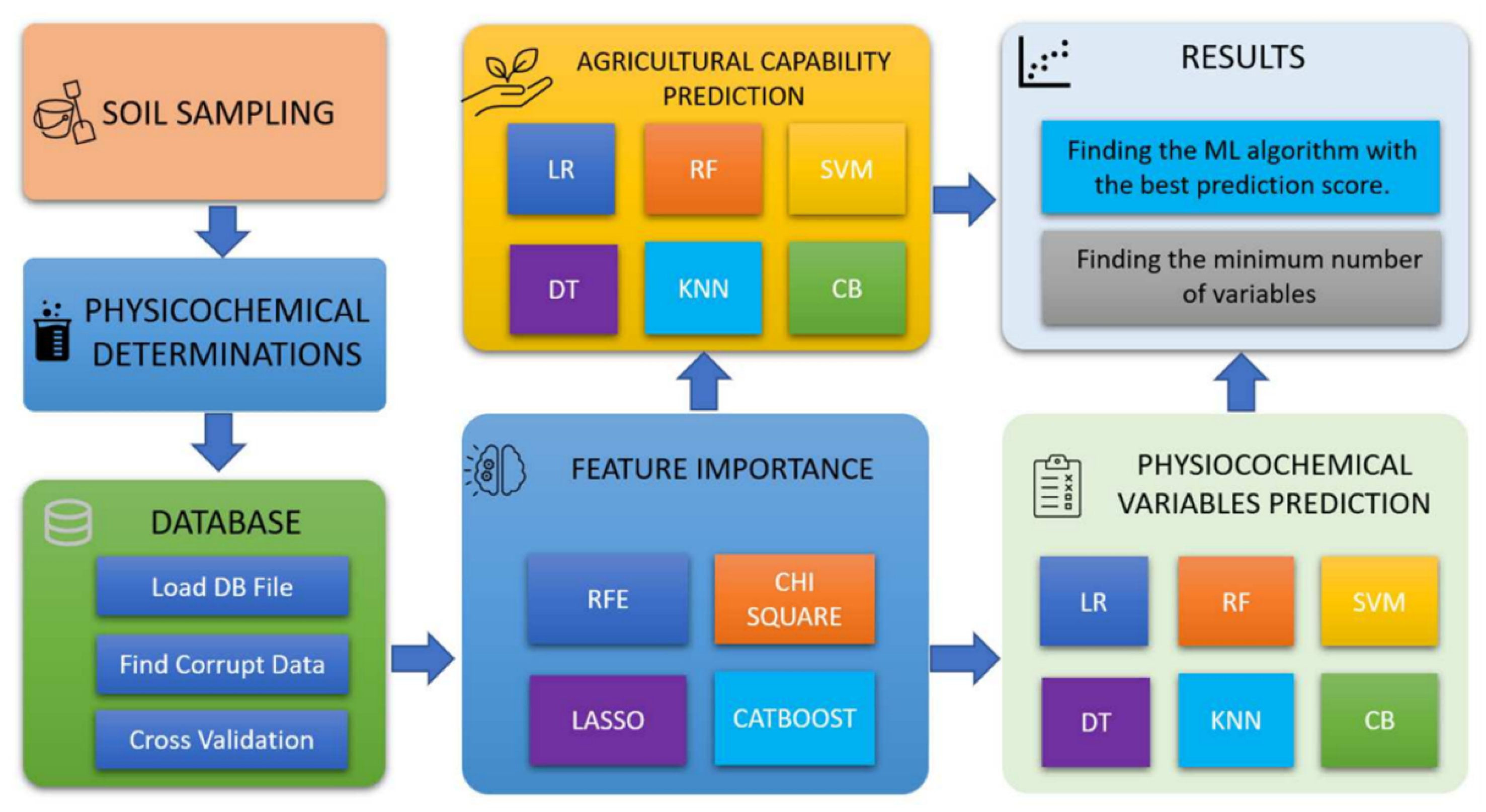
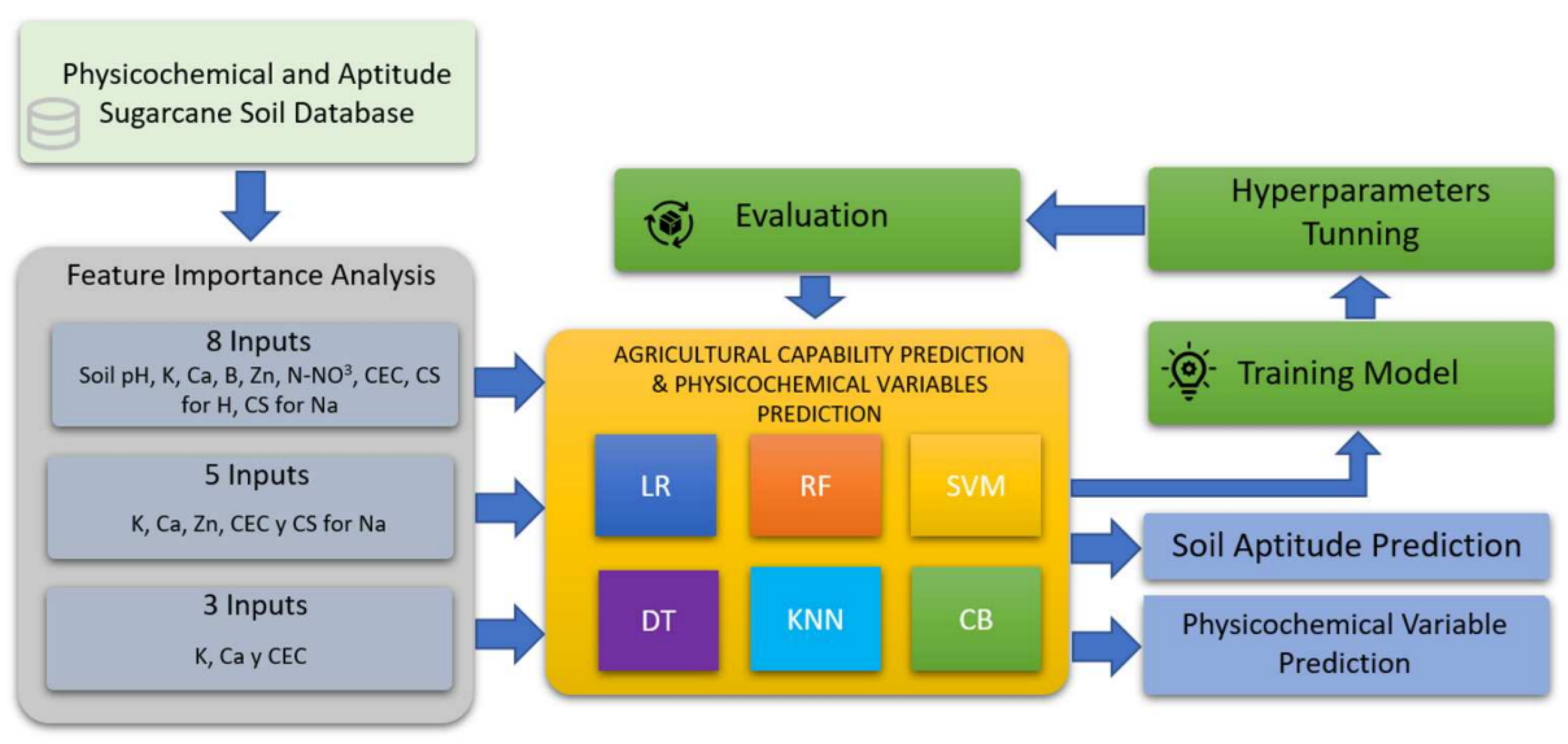
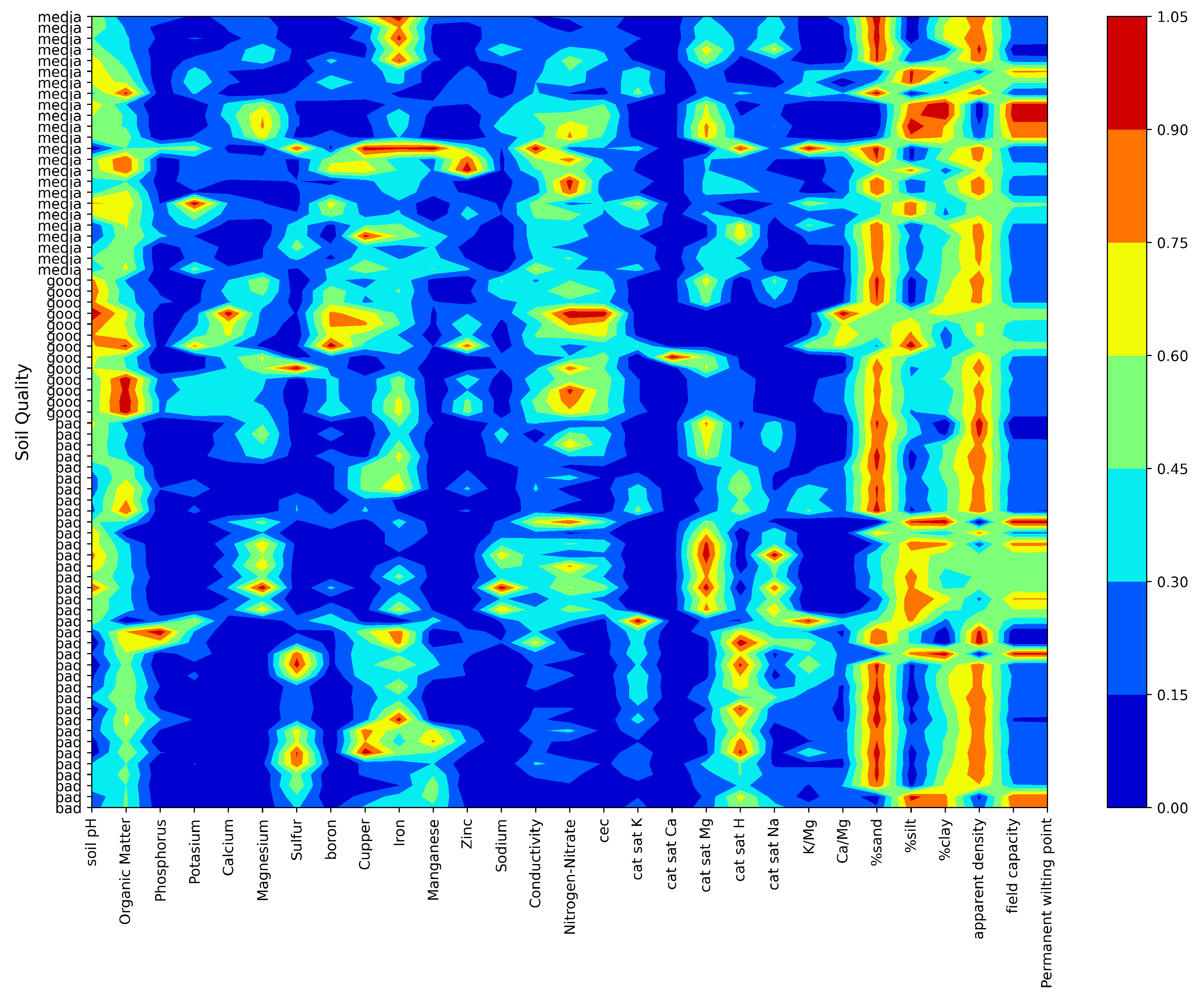
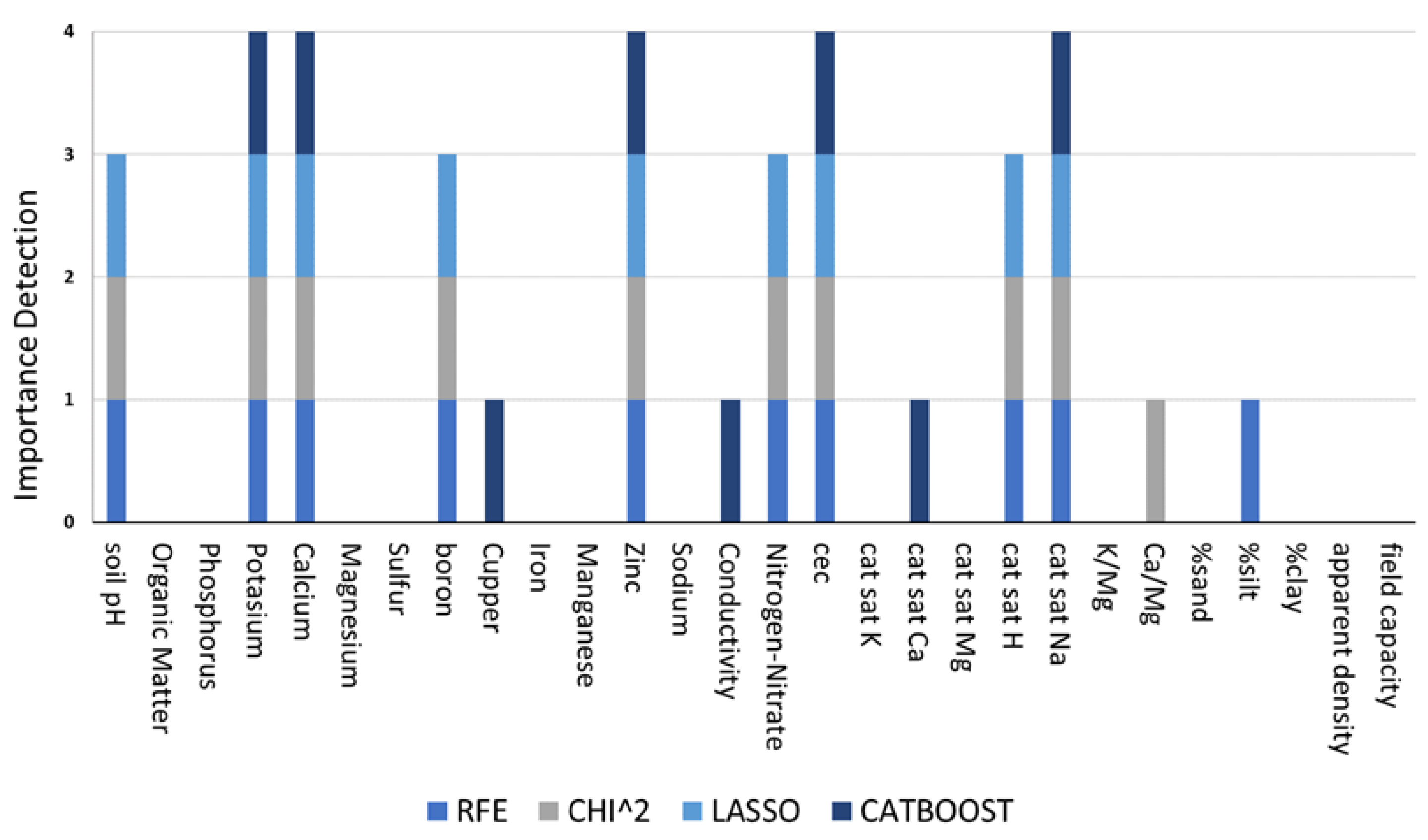
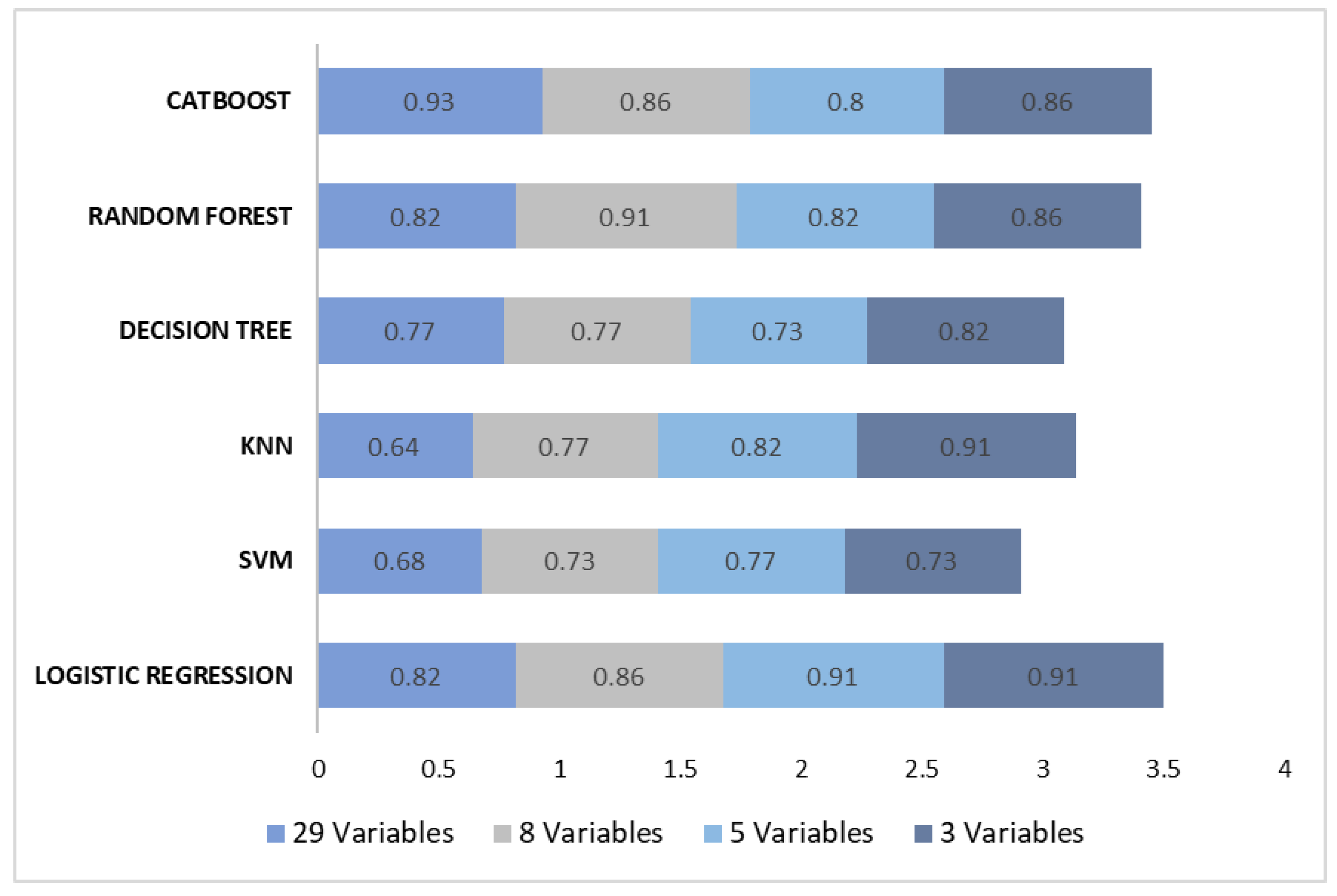


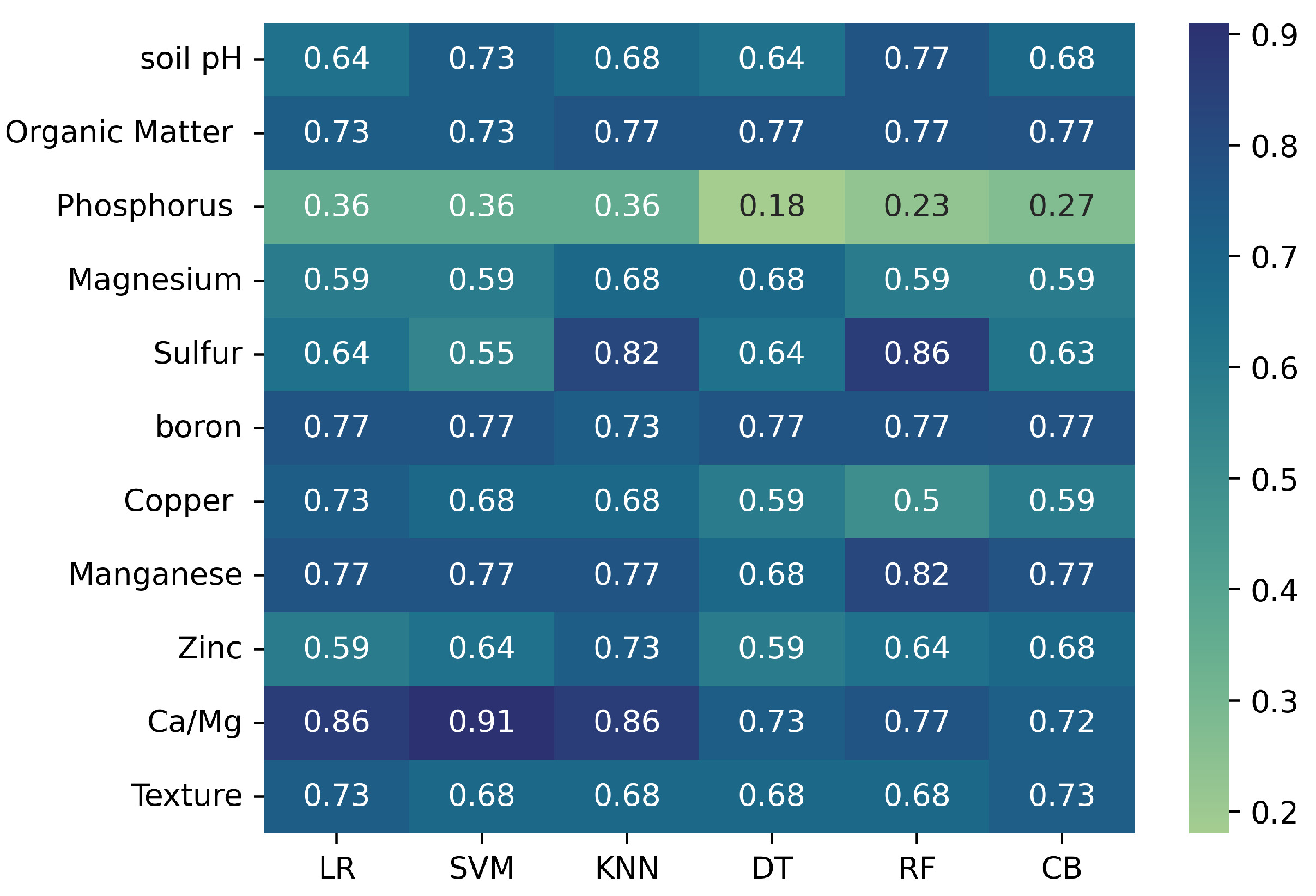
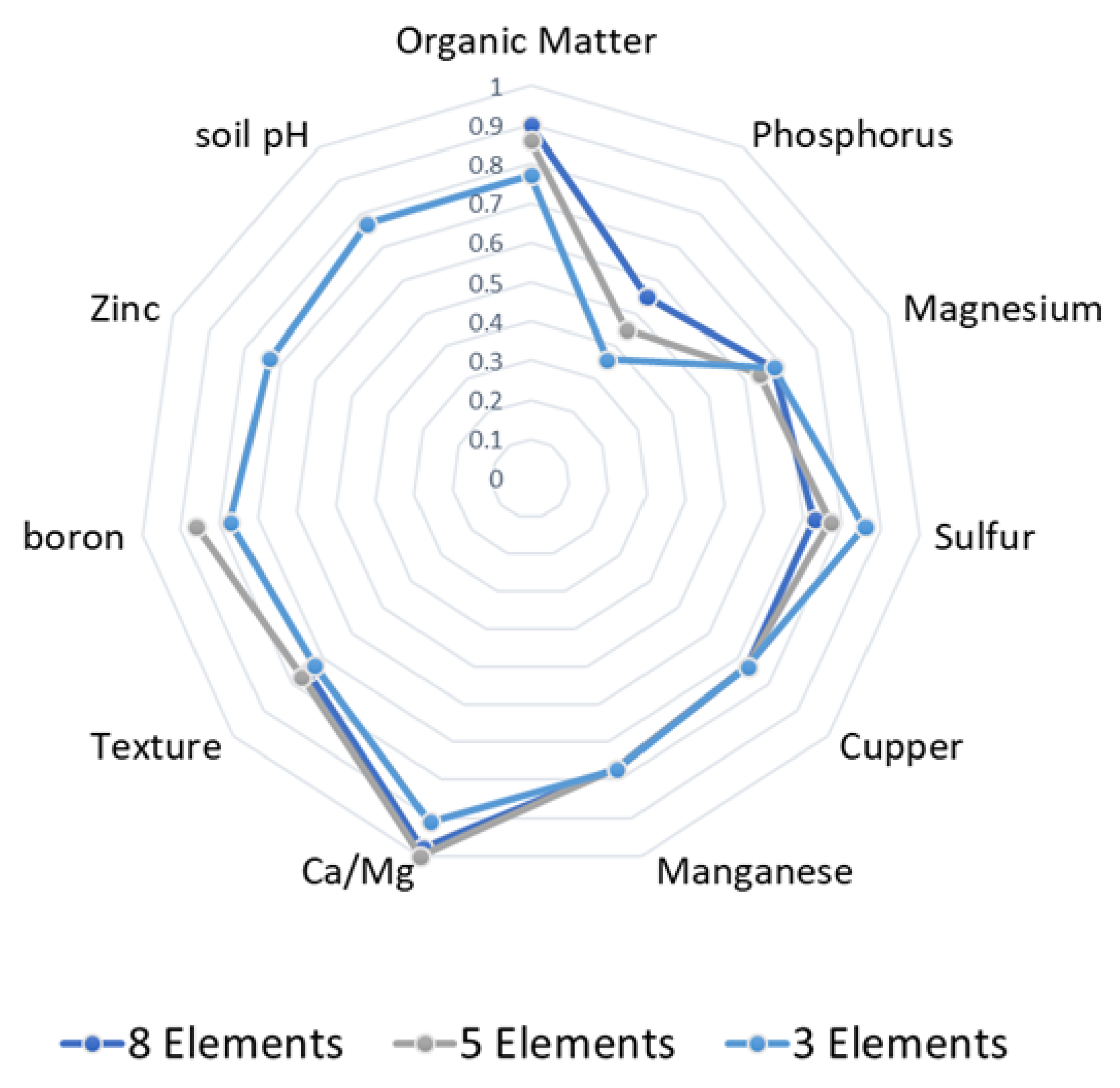
| Name/Ref. | Configuration | Target | Main Contribution |
|---|---|---|---|
| [20] | Comparative assessment of the cubist model and the quantile random forest models | Soil fertility index map | The topographic covariates had strong predictive ability for all the soil properties along with the bioclimatic variables. |
| [21] | Visible near-infrared spectroscopy and machine learning models, such as Partial Least Square Regression (PLSR), Support Vector Machine (SVM), and Wavelet Neural Network (WNN) | Soil organic carbon | A combination of the techniques was most suitable in pre-processing data with different models. |
| [22] | Visible near-infrared spectroscopy (VIRS) and machine learning (PLSR), Support Vector Machine (SVM), Artificial Neural Networks (ANN), cubist combined with VIRS | Soil organic matter | The combination of algorithms resulted in more precise calibration–validation models. |
| [23] | Successive projections algorithm (SPA), competitive adaptive weight weighting algorithm (CARS), and the combination of Smart Process Automation (SPA) and (CARS) | Soil organic matter | The combination of algorithms resulted in more precise calibration–validation models. |
| [24] | Kriging interpolation, density-based spatial clustering of applications and noise (DBSCAN) validated with random forest (RF) algorithms | Soil fertility degradation (SFD) | Implementing Random Forest and clustering provided an accuracy above 95%. |
| [25] | SVM model paired with 7 Gaussian Process, Random forest (RF) and multi-linear regression (MLP) | Permeability of soil (PS) | The parameters of time and water head were the most effective to estimate permeability of soil. |
| [26] | Artificial intelligence model based on ANN | Hydraulic conductivity (Ks) | The model predicts Ks by means of soil parameters, such as silt, clay, organic matter, bulk density, pH, and electrical conductivity. |
| [27] | Architectural model | Soil fertility | The model predicted organic matter and clay |
| [28] | Extreme Learning Machine model with different activation functions | Available phosphorus, available potassium, Organic carbon (OC), B, and pH | The model predicted four of the five parameters evaluated. |
| [29] | Various machine learning techniques (K-Nearest) | Land susceptibility zonation (LSZ) | The susceptibility maps of the Landslid model paired with the extreme learning adaptive neuro fuzzy inference system (LSM-ELANFIS-VII) provided the most accurate results. |
| [30] | Neighbor Naïve Bayes (KNN), Multinomial Logistic Regression, | Soil nutrient quality | Two models were accurate and some uncertainties in the process are to be studied. |
| [31] | ANN and RF | Mustard crop yield | The parameters used were pH, electrical conductivity (EC), OC, Nitrogen (N), P, K, S, Cu, iron (Fe), Zinc (Zn) and Mn and the most accuracy was obtained with the KNN and the ANN. |
| [32] | Evaluation of soil nutrient content through machine learning models | Soil nutrient quality | Two models were accurate and some uncertainties in the process are to be studied. |
Disclaimer/Publisher’s Note: The statements, opinions and data contained in all publications are solely those of the individual author(s) and contributor(s) and not of MDPI and/or the editor(s). MDPI and/or the editor(s) disclaim responsibility for any injury to people or property resulting from any ideas, methods, instructions or products referred to in the content. |
© 2023 by the authors. Licensee MDPI, Basel, Switzerland. This article is an open access article distributed under the terms and conditions of the Creative Commons Attribution (CC BY) license (https://creativecommons.org/licenses/by/4.0/).
Share and Cite
Landeta-Escamilla, O.; Alvarado-Lassman, A.; Sandoval-González, O.O.; Flores-Cuautle, J.d.J.A.; Rosas-Mendoza, E.S.; Martínez-Sibaja, A.; Vallejo Cantú, N.A.; Méndez Contreras, J.M. Determination of Soil Agricultural Aptitude for Sugar Cane Production in Vertisols with Machine Learning. Processes 2023, 11, 1985. https://doi.org/10.3390/pr11071985
Landeta-Escamilla O, Alvarado-Lassman A, Sandoval-González OO, Flores-Cuautle JdJA, Rosas-Mendoza ES, Martínez-Sibaja A, Vallejo Cantú NA, Méndez Contreras JM. Determination of Soil Agricultural Aptitude for Sugar Cane Production in Vertisols with Machine Learning. Processes. 2023; 11(7):1985. https://doi.org/10.3390/pr11071985
Chicago/Turabian StyleLandeta-Escamilla, Ofelia, Alejandro Alvarado-Lassman, Oscar Osvaldo Sandoval-González, José de Jesús Agustín Flores-Cuautle, Erik Samuel Rosas-Mendoza, Albino Martínez-Sibaja, Norma Alejandra Vallejo Cantú, and Juan Manuel Méndez Contreras. 2023. "Determination of Soil Agricultural Aptitude for Sugar Cane Production in Vertisols with Machine Learning" Processes 11, no. 7: 1985. https://doi.org/10.3390/pr11071985
APA StyleLandeta-Escamilla, O., Alvarado-Lassman, A., Sandoval-González, O. O., Flores-Cuautle, J. d. J. A., Rosas-Mendoza, E. S., Martínez-Sibaja, A., Vallejo Cantú, N. A., & Méndez Contreras, J. M. (2023). Determination of Soil Agricultural Aptitude for Sugar Cane Production in Vertisols with Machine Learning. Processes, 11(7), 1985. https://doi.org/10.3390/pr11071985









